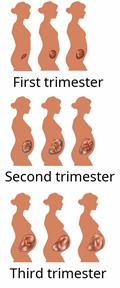How Your Baby Grows During Pregnancy: What to Know
Pregnancy starts when a fertilized egg attaches to the lining of the uterus and begins to grow. It is a time of many changes in the mother's body. The changes happen:
How long does a pregnancy last?
A pregnancy usually lasts 280 days, or about 40 weeks. Pregnancy is divided into three periods of growth, also called trimesters:
First trimester: weeks 0–13.
Second trimester: weeks 14–27.
Third trimester: weeks 28–40.
The end of the 40 weeks of pregnancy is your likely date of delivery, or due date. However, most babies are not born on their due date.
How does my baby develop month by month?

First and second month
-
The brain, spinal cord, and heart begin to develop.
-
By 6 weeks, the heart begins to beat.
-
The face, arms, and legs begin to form. Then the hands and feet begin to develop.
-
All major organs begin to develop by the end of the second month.
Third month
-
All of the internal organs are forming.
-
Bones and muscles are beginning to grow.
-
The fetus is making movements similar to breathing.
-
Fingernails and toenails are forming.
Fourth month
-
The skin is thin and transparent.
-
The neck, outer ear, eyelids, and fingernails are formed.
-
The external sex organs are formed.
-
The fetus can hear, swallow, and move easily.
-
The kidneys begin to make pee (urine).
Fifth month
-
The fetus moves around more and can be felt for the first time (quickening).
-
The face, nose, and lips can be seen easily on ultrasound.
-
The baby is covered with soft hair called lanugo.
-
The organs in the digestive system work.
Sixth month
-
The lungs continue to grow and mature.
-
The eyes open. The brain continues to develop.
-
The fetus may begin to suck a finger.
-
Skin ridges are formed that will be fingerprints and toe prints.
-
Hair grows thicker and eyebrows can be seen.
Seventh month
-
Lungs are fully developed but not yet ready for birth.
-
Eyes are developed enough to sense changes in light.
-
The fetus responds to sound.
-
The fetus kicks and stretches.
-
Hands can make a grasping motion.
-
Vernix, a waxy coating, is starting to develop to protect the skin.
Eighth month
-
Most organs and body systems are fully developed and working.
-
Bones harden, and taste buds develop. The fetus may hiccup.
-
The brain is still developing. The skull remains soft.
-
By week 31, most development is complete and the fetus is gaining weight fast.
-
By the end of week 32, the fetus weighs a little more than 4 pounds (1.8 kg).
Ninth month until your due date
-
The lungs are fully developed and ready for birth.
-
Patterns of sleep develop.
-
The fetus weighs around 6 pounds at the beginning of the ninth month and may weigh around 8 pounds by your due date.
-
The fetus's head typically moves into a head-down position in the uterus.
-
Closer to your due date, the fetus's head may drop lower in your hips.
How do I know if my baby is developing well?
Always talk with your health care provider about any concerns that you may have about your pregnancy and your baby. At prenatal visits, your provider will do tests to check on your health and keep track of your baby's growth. These include:
You may also have a second trimester ultrasound to check your baby's development.
Follow these instructions at home:
This information is not intended to replace advice given to you by your health care provider. Make sure you discuss any questions you have with your health care provider.
